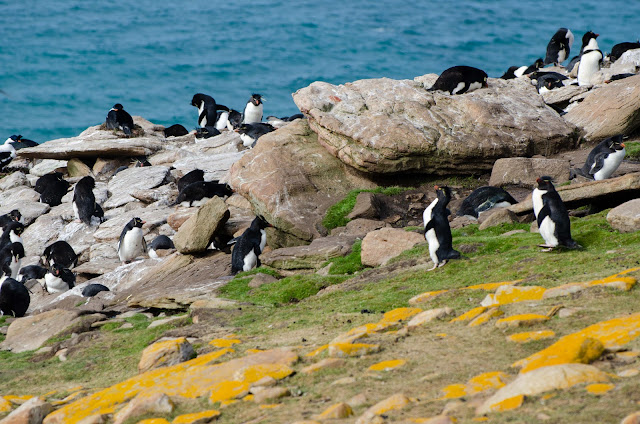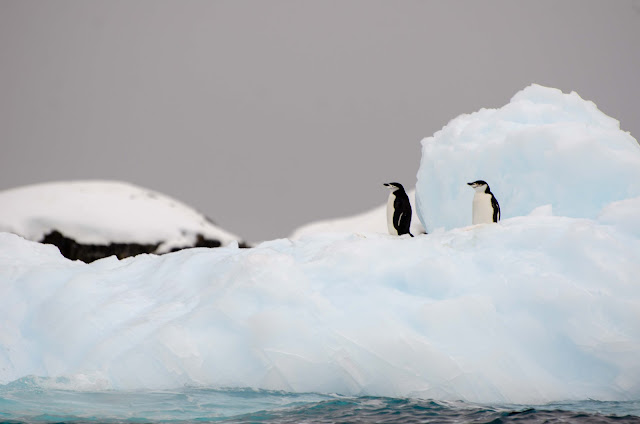Penguins, penguins and more penguins!

Gentoo penguins photo by Anjani Ganase
The Antarctic continent is a massive icescape where only the most adaptable organisms can survive. Marine animals are abundant around Antarctica, and everywhere there are the penguins. Sharing a common ancestor with the albatrosses and petrels, penguins have ditched flying for stealthy swimming and gentlemanly walking. The earliest known penguins came about ~ 60 million years after the mass-extinction event that took out the dinosaurs. Today, penguins have refined their adaptations as they continue to occupy the most extreme and coldest continent of the planet, carving out their niche for survival. They have incredibly thick layers of densely packed and waterproof feather, thick skin and fat. Their vision is adapted for the icy water and they are masters of polar oceans.
Because of the Avian flu epidemic, visitors were not allowed to approach them but we observed these birds from a distance of 5 m. Observers are not allowed to bend or squat in Antarctica to reduce the risk of clothing or equipment touching the ground and transmitting any bio-hazard. Back on the boat, our boots and pants were power washed and disinfected. Humans are vectors of diseases and along with the privilege of being on the continent, we had the responsibility to not add any distress. Penguins are threatened by the rapidly changing climate that is radically altering their ecosystems by reducing their food supply, suitable nesting sites and increasing the number of diseases. The Western Antarctic Peninsula, where many penguin colonies occur is warming faster than anywhere else on the planet (average temperature has increased 2.4 C since 1958). Here, are some of the penguins of Antarctica that won our hearts.

Gentoo penguin photo by Anjani Ganase 
A colony of Gentoos photo by Anjani Ganase
Gentoo Penguins
Gentoo penguins have the classic orange beak and white band over their eyes, and a large brushtail from which they get their latin name Pygoscelis. By far the most abundant and charismatic of the group they have large colonies in the sub-Antarctic (Falklands, South Georgia islands) and Antarctica. They are favoured prey for leopard seals, orcas. Almost every site had a colony of Gentoo penguins. They are de-sensitized to humans, neither interested nor deterred. Gentoos are the climate winners in the region, increasing in populations as they occupy Antarctic and sub-Antarctic areas, suggesting that they have a wide variety of food options and are more tolerant of the warming conditions. They nest in colonies on top of rocks, mosses and feathers.

Adelie penguins photo by Anjani Ganase
Adelie penguins
Adelie penguins are named after the wife (Adele) of the scientist, Jules Dumont d’Urville, who was part of the French Antarctic expedition team that first saw the species. Adelie penguins can be distinguished by their all black head with a white ring around their eyes. In contrast to the Gentoo penguins, Adelie penguins only occur along the Antarctic continent and are climate losers along the Western Antarctic Peninsula where populations have plummetted by 70 % since 1982. In contrast, Adelie populations in Eastern Antarctica have increased nearly seven fold. Adelie penguins rely on floating sea ice to feed on the krill that gathers around the ice feeding on algae and microbes. Adelies are less inclined to catch fish. In the summer they also build their nests along rocky slopes made from pebbles and lay two eggs at a time.

Southern Rockhopper penguins photo by Anjani Ganase 
Southern Rockhopper penguins photo by Anjani Ganase
Southern Rockhopper penguins
The punk rockers of the penguin world, Rockhoppers have red eyes and the iconic yellow plumes behind their eyes and a spiky plume of black feather on top of its head. We watch these small (two feet) penguins hop out of crashing waves on to rocks, then hop and scramble over 50 m up the sides of cliffs to reach their nests close to the tops. Southern Rockhoppers are a sub-Antarctic species that live on the rocky coasts of the sub-Antarctic Islands, including Falkland Islands and South Georgia islands. Despite not being poached, populations have declined by 30 % over the last 30 years. This is likely related to the changes in the Antarctic food web as a result of industrial fishing in open waters.

Chinstrap penguins photo by Anjani Ganase
Chinstrap penguins
Chinstrap penguins are easily identified by the black band that runs under their beaks to the sides of their head, making them look as if they are prepared for anything. Chinstrap penguins are the most abundant species on the continent. They escape the sea ice during the winter and head back to nest during the summer (October to February) when the ice starts melting. They are closely related to the Gentoos and Adelies. Like the Adelies, they also forage for krill around the floating ice but can forage farther out to sea.

Magellanic penguin photo by Anjani Ganase
Magellanic Penguins
These are a species of South American penguins also found on the Sub-Antarctic Islands. This black and white penguin has distinct black and white bands around the white belly, and a thin black band around the neck. It was named after the Portuguese explorer Ferdinand Magellan, who first spotted them in 1520. Major threats to this species have been fishing activities around the South American continent, and incidental catches in nets, as well as chronic oil spill pollution.

King Penguins and chicks photo by Anjani Ganase 
King Penguin photo by Anjani Ganase
King Penguins
The King penguins are the second largest penguins, second to the Emperor penguins that are a close relative. They have regal look with bright orange ear patches that extend down to their chests. The King penguins also only occur on the sub-Antarctic Islands. We saw them on an especially warm day on Saunders Island trying to keep cool on the beach. The chicks can be as large as the adults but are covered in a thick brown fluffy down. After heavy exploitation in the 19th and 20th century for their fat for oil, the populations have stabilised.
Emperor Penguins
The largest of all, the Emperor Penguins can grow to almost four feet and live up to 88 years. Their ear patches are orange and white and are continuous with the white belly. Emperor penguins can live through the Antarctic winters on the sea ice, keeping warm by huddling together. Unlike other penguins, Emperor Penguins lay one egg and while the father keeps the egg warm by balancing it on its feet and covering it in feathers, the mother will make her way, sometimes up to 50 miles away to get food. The father does not feed for the whole breeding season. Unfortunately, we didn’t see any Emperor Penguins as there are not many colonies along the Antarctic Western Peninsula.
References
Cole, T.L., Zhou, C., Fang, M. et al. Genomic insights into the secondary aquatic transition of penguins. Nat Commun 13, 3912 (2022). https://doi.org/10.1038/s41467-022-31508-9


